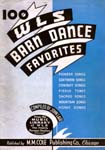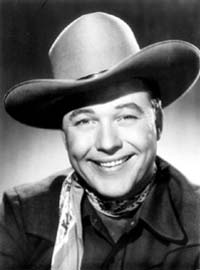



|
 |
|||||||||||||||
|
About The Artist
Dusti Lynn told readers that Monte had an ambition to learn how to play the guitar when he was just thirteen years old. He went to work picking cotton and after a month, he had earned and saved all of $8.50 which enabled him to get the best guitar he could find for the money. He taught himself to play and seemed to have a natural singing voice. Although he made more discs than the unrecorded Bob Baker, his recorded output was much smaller than that of most of the others who had country voices. Some singing cowboys sang like Nelson Eddy and were not remotely "country," e.g. Fred Scott, Jim Newell, and Dick Foran. Monte had a pleasant Texas style vocal. Although born in Oklahoma, he spent part of his growing up years in San Angelo, Texas. The start of Monte's career is subject to some variations. A "Hollywood Notebook" column published in the El Paso Times in November 1941 indicated that a young George Sherman was staying at the Lone Palm Hotel in Palm Springs, CA. He directed western movies at Republic. The story goes that Monte came to town with only his guitar and an extra cowboy shirt. Someone invited him to sing a few tunes in the hotel's lounge where Sherman happened to be in the audience. As a reesult of that, Monte got a singing part in Sherman's next movie - Stage Coach Express (1942), which ws starring a new cowboy - Donald (Red) Barry.
Another source indicates he made his film debut as an uncredited singer in "The Big Bonanaza" in 1944. The IMDb online source listed him as a "saloon singer" in the movie. During World War II the young westerner sang in clubs and in War Bond drives. At one of the latter he was heard by theater owner Phil Isley (father of Oscar winner Jennifer Jones) who recommended him to Herbert Yates of Republic Pictures. Signed to a contract, he took the movie name Monte Hale and appeared in a few small parts until promoted to his own series in 1946. As the series progressed he sang less than Autry, Rogers and Ritter. Monte's appearances at War Bond drives took him across the country. One such event was in Liberty, TX in June 1944. Monte appeared at the drive along with Jean Brooks, a Hollywood starlet, and character actor Raymond Walburn.
Jack Lawson told readers that the highlight of that rally was the appearance of Gene Autry in his flight officer uniform. He brought along his white cowboy hat worn in the movie South of the Border. Monte Hale was the master of ceremonies and auctioneer for this gala event. Bond Orders were written up by the women of the Studio City Ambulance and Defense Corps. Monte would often be at Hoot Gibson's Painted Post as the emcee of the informal shows put on as well as doing a few vocals backed by the Painted Post Rangers. Hale's recording career was even more sparing. He made sixteen songs for the Bel-Tone, Gold Seal, and MGM labels. His best-known song was a patriotic number about the Statue of Liberty called "The Statue in the Bay." The Bel-Tone label was out of Los Angeles. But while promotional ads were run in The Billboard, the label may not have been in good financial condition.
During 1946, a series of Wednesday night radio parties were begun by Ken Chrisman over at Hoot Gibson's Pained Post. As part of the show, Ken would hand out awards and trophies to outstanding Western performers. Spade Cooley drew a large crowd when he was at the venue to accept his award as the outstanding Western band leader of 1945. Carolina Cotton was also given an award prior to that for her yodeling. It appears that on Wednesday night, January 9, 1946, Monte Hale had the spotlight on him as he received an award for "most promising young western star of 1946." The events were broadcast over KXLA around 11pm. By the end of 1946, Bel-Tone Records filed for bankruptcy. Creditors included American Federation of Musicians, Monarch Recording Company, publishing and artist royalties due. Dick Elwell and Bob Cook were the company's sole stockholders. Because a mortgage was said to be held against the label's masters, possible revenue from their sale may not have been realized by the creditors. Monte did not do much to promote a singing career after his film career ended like Rex Allen, Eddie Dean, Tex Ritter and Jimmy Wakely. He did later appear in a few movie bit parts.
In 1948, Lee Penny put together the "Country Carnival" show that was to air over KMPC and KFI-TV. The first show was held on October 23, 1948 at the San Gabriel Civic Auditorium. KFI would air 90 minutes while radio station KMPC would air the entire show. THe auditorium had a capacity of 1,500 seats. Each week would have guest stars. Regulars on the show were to be Carl (Squeakin Deacon) Moore as emcee; T. Texas Tyler; Max Terhune; Tom, Dick and Harry; Monte Hale; Buddy McDowell; Larry Cassidy; Carolina Cotton; Andy Parker and the Plainsmen; the Five Stops; the Three Shiftless Skonks; Grampaw Wiggles; Helpful Hannah; Hank Penny; Ann Jones; Jimmie Walker; Shug Fisher; Ken Curtis;, Ken Card and others. A 1949 interview reveals some insight as to his character or beliefs. While he was proud of learning to play the guitar, he felt it better that he finished grammar and high school and would want any kid to do the same. He said, "A boy that plays hooky isn't cheating anyone but himself. And no matter what he hopes to do when he's grown up, having an education will be his biggest asset. Maybe this sounds stuffy, but it's a truth that kids better accept." In the spring of 1950, Monte was signed by Arena Stars to a personal management contract. That led to his signing with the MGM record label. Around that same time, Monte had secured his release from Republic Pictures where he had done about 20 monvies.
In 1954, a column in the Los Angeles Times indicated that Monte had been serving as the master of ceremonies for the Mae West show at the Mapes Hotel in Reno, NV. That led to him becoming a permanent fixture in her night club show. After his run of Western movies ended, he would make occasional appearances in other movies. He appeared in Yukon Vengeance in 1954 and later in 1966 with Robert Redford as a Texas prison escapee in The Chase; Marlon Brando was the sheriff. His final film was Guns of a Stranger that starred Marty Robbins as a singing cowboy. His marriage to Charie DeCastro of the DeCastro Sisters fame was reported in the news. The account by Hedda Hopper indicates they were married on Tuesday, July 12, 1955 in Las Vegas, NV. Prior to his marriage to Cherie, he was cited for contempt in Texas for failing to pay in support to his former wife and child (James Michael). Hale had made partial restitution up to that point. Their divorce was granted on July 1, 1947.
His third wife Joanne subsequently served as director of the Gene Autry Museum of Western Heritage. Looking casually at his movie career, Hale once said that he made more from royalties on his comic books than films and records. It was written that there were six Monte Hale series of dime picture books that were published in 27 languages. He married former Joanne (Levitov) Haverback (She previously married Bernard Haverbanck on September 18, 1947) on November 20, 1977. On November 12, 2004, he received a "star" on the famed Hollywood Walk of Fame. However, he did have one major achievement—he outlived all his singing cowboy rivals. When Monte passed away in late March of 2009 in Studio City after a long illness. The obituaries read cover the early tale of how Monte got his foot in the door as a singer and eventually with Republic Pictures. In all, he starred in 20 movies. Notable Hollywood stars that were in his films were such people as Robert Blake and James Dean. His brother was appeared with him in one film, Giant. He was a life-long friend of Gene Autry. Together they co-founded the Gene Autry Western Heritage Museum which later became the Autry Museum of Western Heritage and part of the Autry National Center. Jackie Autry stated that she knew Hale for almost 30 years and was their best friend. Credits & Sources
Get The Music
|
|||||||||||||
| Printer Friendly Version |
|
Recordings (78rpm/45rpm)
| |||||||||||||||||||||||||||||||||||||||||||||||||||||||||||||||||||||||||||||||||||
Hillbilly-Music.com
Yes, Hillbilly Music. You may perhaps wonder why. You may even snicker. But trust us, soon your feet will start tappin' and before you know it, you'll be comin' back for more...Hillbilly Music.
Hillbilly-music.com ...
It's about the people, the music, the history.
|
Copyright © 2000—2023 Hillbilly-Music.com
|
||||